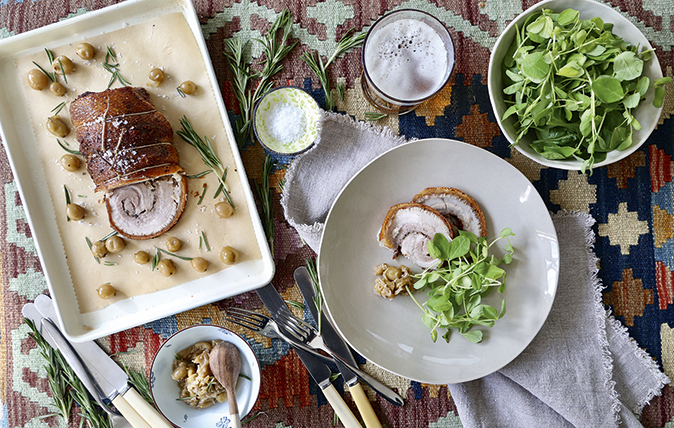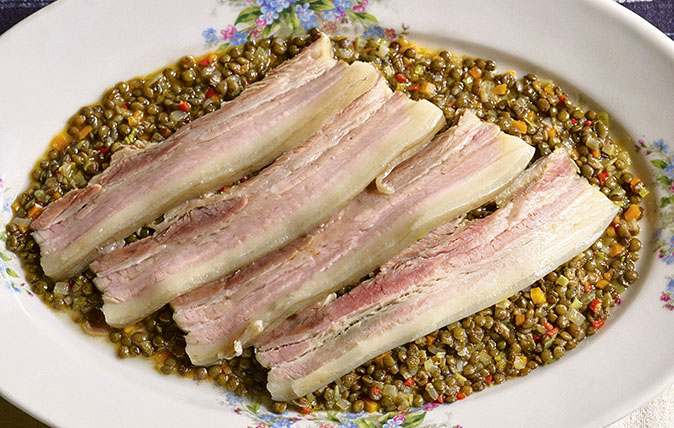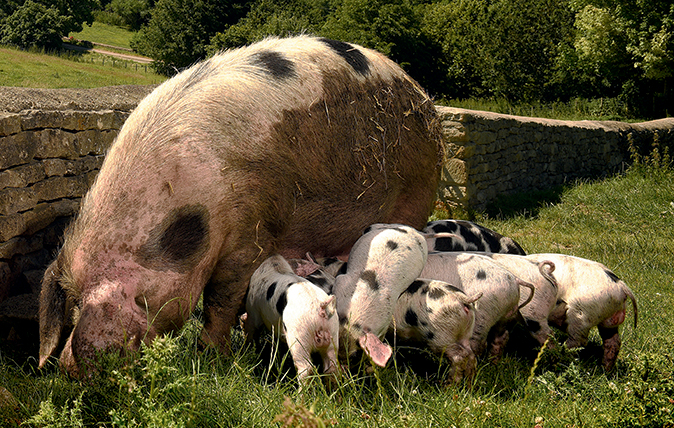Suckling pig: The ultimate epicurean mouthful
A search for the ultimate epicurean mouthful could arguably start and finish with suckling pig. Nick Hammond studies a timeless culinary tradition.


On a hillside overlooking the Tyrrhenian Sea, the soft scent of sunbaked myrtle drifts in the air. It’s cooler up here and the breeze fuels the crackle of logs on an open fire. There’s an intermittent hiss of drizzling fat and the occasional nostril-stinging tang of roasted meat. The pezzo forte of this primal assault on the senses is the mesmerically, inexorably turning spit. Skewered on it is one of the world’s great delicacies, a deep-amber parcel of crispy sweetness. This is suckling pig.
Slaughtered while still on mother’s milk, suckling pig has been a roast of celebration for centuries. The Russians present a dish of it to the crew of a returning navy ship, the Chinese celebrate New Year with its sweet and sour, crunchy hedonism and the Puerto Ricans and Filipinos revere it as a Christmas special.
‘It’s our national dish,’ Mario Tirotto says proudly, wiping sweat from his brow. He’s the head chef at Li Ciusoni restaurant, atop the glittering Valle dell’Erica resort on Sardinia’s northern coast. ‘We have it with our families for special occasions—we call it pulcheddu.
‘A good suckling pig requires four to five hours of cooking and patient preparation,’ he divulges. ‘We’re looking for indirect and slow roasting, which allows the fat to slowly melt and keeps the meat soft. The cotenna – or pork rind – then becomes crunchy and flavourful.’
Mouth watering yet? Luckily, there are plenty of opportunities to get your hands on suckling pig on these shores, too. It’s just been added to the menu of the Michelin-starred Paris House at Woburn, Bedfordshire, for example.
‘Cooked right, it has this incredibly soft, gelatinous texture,’ says head chef and co-owner Phil Fanning. ‘Our suckling pig is served in individual portions and it takes some skill to be able to butcher it down while retaining all those incredible flavours and still keeping the dish attractive.’
Although downsizing the pig into mere mouthfuls of unctuousness makes serving individual portions easier, celebratory occasions sometimes require the grand entrance of a whole beast – even with an apple in its mouth, if you prefer. There are several restaurants skilled in cooking it in this way, but be aware that you’ll probably be required to pay a deposit up front as it’s a large dish requiring long and careful cooking. Even a smallish animal will feed 10–12 people with ease.
Sign up for the Country Life Newsletter
Exquisite houses, the beauty of Nature, and how to get the most from your life, straight to your inbox.
Lunya, a Catalan restaurant in Liverpool, serves suckling pig so meltingly cooked it can be carved in the traditional Spanish manner – with plates, rather than knives. In Cardiff, The Potted Pig prides itself on being able to deliver crunchy platters of freshly roasted suckling pig on special request.
John Man, restaurant manager at China Tang in London’s Dorchester, W1, offers a killer version of Chinese suckling pig and you’ll also find mouthwatering examples in Chinatown itself. Wesley Smalley, executive chef at the Oriental Club, London W1, prepares a renowned version for members, which is rubbed with salt and Szechuan pepper, then stuffed with garlic and fresh ginger.

If you’re feeling ambitious, you can even tackle the chef’s duties yourself. ‘It’s perfectly feasible to cook suckling pig really well at home,’ says Richard Pugh of Pugh’s Piglets (01995 601728; www.pughspiglets.co.uk), supplier to some of the brightest stars in the culinary firmament. ‘If you’re tackling the whole thing, bones and all, you’ll need to be prepared for some work to carve it up. You might want to consider the option of porchetta, which has been hugely popular for us.’
Opting for porchetta – boned and rolled suckling pig – means you can deliver a striking table classic with the minimum of fuss. Pat dry, rub with salt and a little oil, cook on high for half an hour and reduce to 180ºC for the remainder of the cooking time for a saliva-inducing, creamy, salty sensation. Oh, and don’t forget to cover its ears, snout and tail with tin foil, to prevent burning.
Scottish poet and writer George Mann MacBeth best sums up the sheer hedonistic delight a steaming platter of suckling pig produces: ‘Heap high the groaning platter with pink fillets, suckling pig and thick gammon, celestial chef. Be generous with the crackling. Let your hand slip with the gravy trough, dispensing plenty.’
Places to pig out
- Paris House, Woburn, Bedfordshire (01525 290692; www.parishouse.co.uk)
- Lunya, Liverpool (0151–706 9770; www.lunya.co.uk)
- The Potted Pig, Cardiff (029–2022 4817; www.thepottedpig.com)
- China Tang at The Dorchester, London W1 (020–7629 9988; www.chinatanglondon.co.uk)
- St John restaurants, London (020–7251 0848; www.stjohngroup.uk.com)
- Oriental Club, London W1 (020–7629 5126; www.orientalclub.org.uk)

Credit: Melanie Johnson
Slow-roasted, gooseberry-stuffed rolled pork belly with gooseberry relish
Gooseberries should be enjoyed in both savoury and in sweet dishes.

Credit: Jason Loewe
Perfect pork recipes you won’t be able to resist pigging out in over the winter months
Simon Hopkinson reminisces about a childhood holiday in France which left him with a love of charcuterie food that lasts

Top native pig breeds
Our traditional pig breeds are a delight to look at and tasty to eat - which is your favourite?
Country Life is unlike any other magazine: the only glossy weekly on the newsstand and the only magazine that has been guest-edited by HRH The King not once, but twice. It is a celebration of modern rural life and all its diverse joys and pleasures — that was first published in Queen Victoria's Diamond Jubilee year. Our eclectic mixture of witty and informative content — from the most up-to-date property news and commentary and a coveted glimpse inside some of the UK's best houses and gardens, to gardening, the arts and interior design, written by experts in their field — still cannot be found in print or online, anywhere else.

